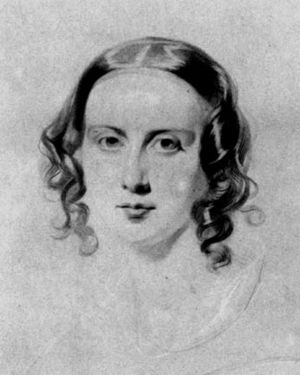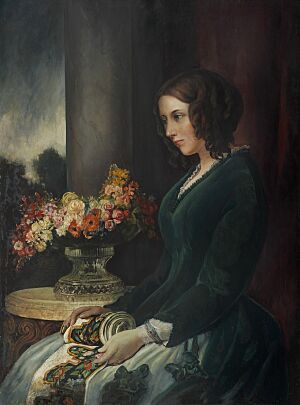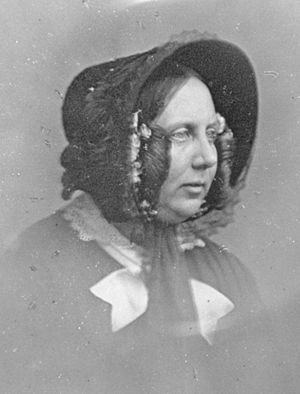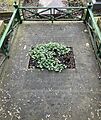Catherine Dickens facts for kids
Quick facts for kids
Catherine Dickens
|
|
|---|---|
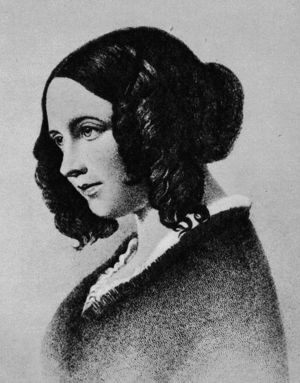 |
|
| Born |
Catherine Thomson Hogarth
19 May 1815 Edinburgh, Scotland
|
| Died | 22 November 1879 (aged 64) London, England
|
| Resting place | Highgate Cemetery, London, England |
| Known for | Wife of English novelist Charles Dickens |
| Spouse(s) | |
| Children | Charles Culliford Boz Dickens Mary Dickens Kate Macready Dickens Walter Landor Dickens Francis Jeffrey Dickens Alfred D'Orsay Tennyson Dickens Sydney Smith Haldimand Dickens Sir Henry Fielding Dickens Dora Annie Dickens Edward Dickens |
| Parent(s) | George Hogarth Georgina Thomson |
Catherine Thomson "Kate" Dickens (born Hogarth; 19 May 1815 – 22 November 1879) was the wife of the famous English writer Charles Dickens. She was also the mother of their ten children and wrote a book about managing a home.
Contents
Early Life and Marriage
Catherine was born in Edinburgh, Scotland, in 1815. Her family moved to England in 1824. She was the oldest of ten children. Her father, George Hogarth, was a journalist. He worked for the Morning Chronicle, where Charles Dickens was also a young journalist.
Charles Dickens met Catherine when she was 19. He quickly liked her and invited her to his 23rd birthday party. They became engaged in 1835 and married on 2 April 1836. Their wedding took place at St Luke's Church, Chelsea. After their honeymoon, they made their home in Bloomsbury, London.
Catherine and Charles had ten children together. In those early years, Charles wrote that he was very happy in their small home with Catherine.
Family Life
Catherine's sister, Mary Hogarth, came to live with them to help the new couple. Charles Dickens became very close to Mary. Sadly, she died in his arms in 1837 after a short illness. Her death deeply affected Dickens. She later inspired characters in his books, like Little Nell.
Another younger sister of Catherine, Georgina Hogarth, joined their household in 1842. This happened when Charles and Catherine traveled to America. Georgina helped care for their young children while they were away. During this trip, Charles wrote that Catherine was always cheerful and brave. He said she "adapted to any circumstances without complaint."
In 1845, Catherine had a small role in an amateur play that Charles Dickens produced. During one performance, she accidentally fell through a trap door on the stage.
Catherine's Book and Challenges
In 1851, Catherine Dickens published a cookbook called What Shall we Have for Dinner?. She wrote it under the name 'Lady Maria Clutterbuck'. The book offered many menu ideas for meals of different sizes. It also included some recipes. This book was very popular and was printed many times.
Also in 1851, Catherine went through a very difficult time. Her daughter, Dora Annie Dickens, died when she was only eight months old. This caused Catherine a lot of sadness.
Over the years, Charles Dickens became less happy with their marriage. He felt that Catherine was not managing the household well. He also blamed her for having so many children. He even tried to separate their bed by putting a bookshelf between them.
Separation
In May 1858, Charles and Catherine Dickens separated. This happened after Catherine accidentally received a bracelet that was meant for another woman, Ellen Ternan. The separation became very public.
In June 1858, Catherine moved to a new home in Camden Town. The exact reasons for their separation are not fully known. However, there were rumors that Charles Dickens was involved with Ellen Ternan, or even with Catherine's sister, Georgina Hogarth.
After the separation, Georgina Hogarth stayed with Charles Dickens. She helped him manage his home and care for the children. All the children stayed with Charles and Georgina, except for their oldest son, Charles Dickens, Jr., who moved with Catherine.
On 12 June 1858, Charles Dickens published a statement in his journal, Household Words. In it, he denied the rumors about his separation. He said that the problems were private and that the rumors were "abominably false." He also sent this statement to newspapers, and many of them printed it.
Later Years and Legacy
After their separation, Catherine and Charles Dickens did not communicate much. However, Catherine remained loyal to her husband and his memory. She died from cancer in 1879.
On her deathbed, Catherine gave a collection of letters she had received from Charles to her daughter, Kate. She told Kate to give them to the British Museum. She wanted the world to know that Charles had "loved me once."
Catherine Dickens was buried in Highgate Cemetery in London. She was buried with her infant daughter, Dora, who had died many years earlier.
In the Media
Catherine Dickens has been featured in several television shows and movies:
- In 2011, the BBC Two documentary Mrs Dickens' Family Christmas explored her marriage to Charles Dickens. It was presented by Sue Perkins.
- In the 1976 series Dickens of London, she was played by Adrienne Burgess.
- In the 2013 film The Invisible Woman, she was played by Joanna Scanlan.
- In the 2017 film The Man Who Invented Christmas, she was played by Morfydd Clark.
Images for kids
See also
 In Spanish: Catherine Hogarth para niños
In Spanish: Catherine Hogarth para niños


